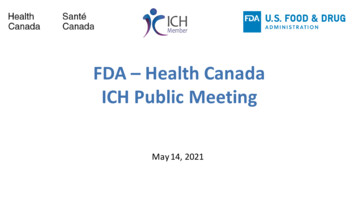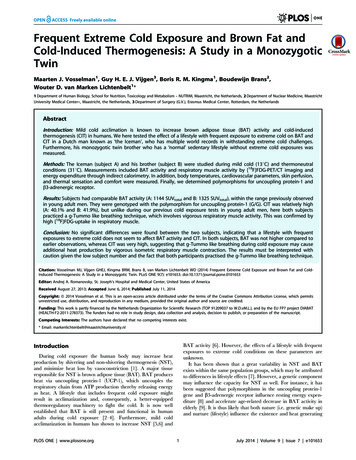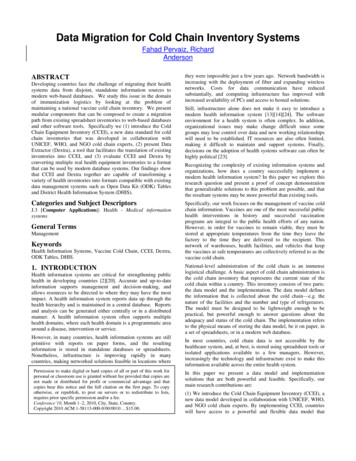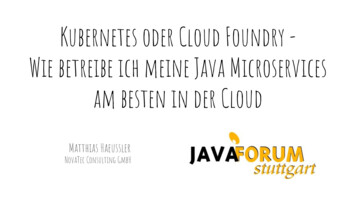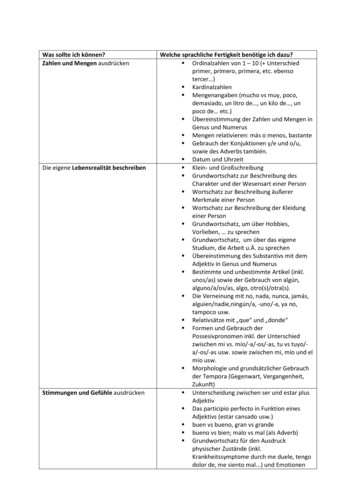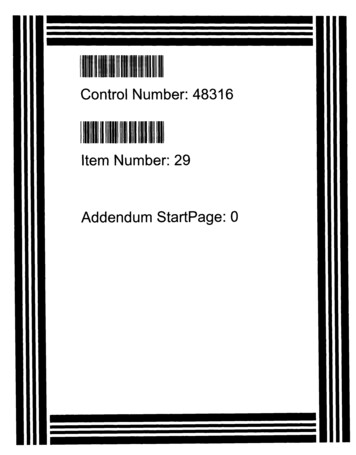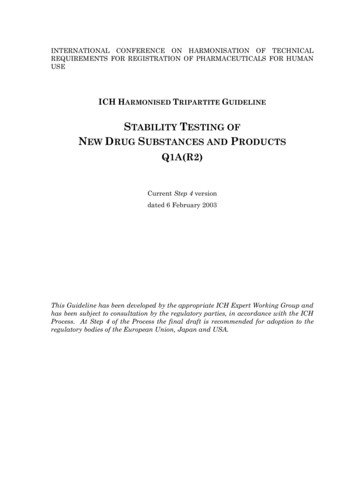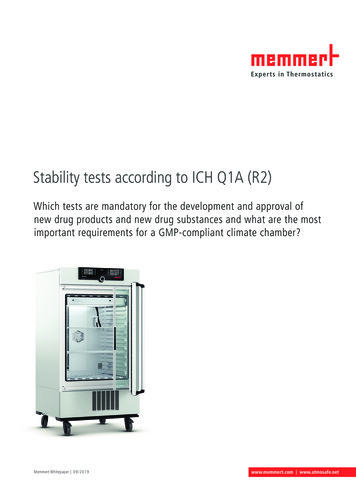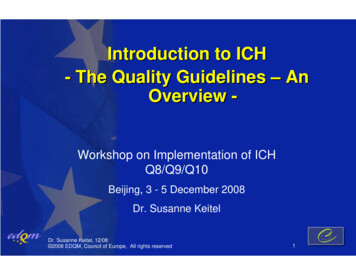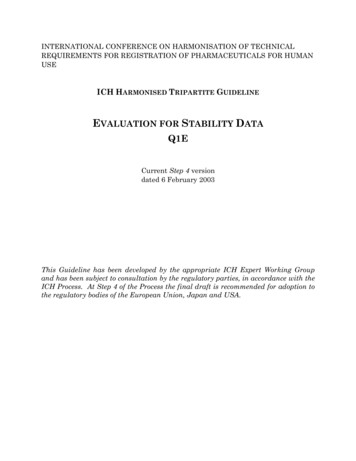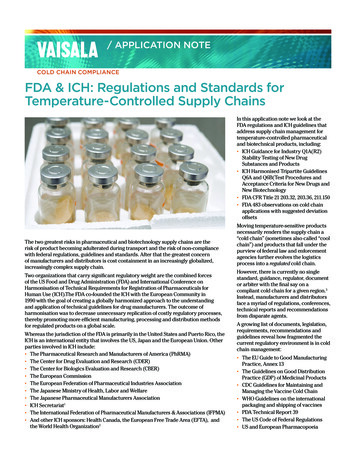
Transcription
/ APPLICATION NOTECOLD CHAIN COMPLIANCEFDA & ICH: Regulations and Standards forTemperature-Controlled Supply ChainsIn this application note we look at theFDA regulations and ICH guidelines thataddress supply chain management fortemperature-controlled pharmaceuticaland biotechnical products, including: ICH Guidance for Industry Q1A(R2)Stability Testing of New DrugSubstances and Products ICH Harmonised Tripartite GuidelinesQ6A and Q6B(Test Procedures andAcceptance Criteria for New Drugs andNew Biotechnology FDA CFR Title 21 203.32, 203.36, 211.150 FDA 483 observations on cold chainapplications with suggested deviationoffsetsThe two greatest risks in pharmaceutical and biotechnology supply chains are therisk of product becoming adulterated during transport and the risk of non-compliancewith federal regulations, guidelines and standards. After that the greatest concernof manufacturers and distributors is cost containment in an increasingly globalized,increasingly complex supply chain.Two organizations that carry significant regulatory weight are the combined forcesof the US Food and Drug Administration (FDA) and International Conference onHarmonisation of Technical Requirements for Registration of Pharmaceuticals forHuman Use (ICH).The FDA co-founded the ICH with the European Community in1990 with the goal of creating a globally harmonized approach to the understandingand application of technical guidelines for drug manufacturers. The outcome ofharmonisation was to decrease unnecessary replication of costly regulatory processes,thereby promoting more efficient manufacturing, processing and distribution methodsfor regulated products on a global scale.Whereas the jurisdiction of the FDA is primarily in the United States and Puerto Rico, theICH is an international entity that involves the US, Japan and the European Union. Otherparties involved in ICH include: The Pharmaceutical Research and Manufacturers of America (PhRMA) The Center for Drug Evaluation and Research (CDER) The Center for Biologics Evaluation and Research (CBER) The European Commission The European Federation of Pharmaceutical Industries Association The Japanese Ministry of Health, Labor and Welfare The Japanese Pharmaceutical Manufacturers Association ICH Secretariat1 The International Federation of Pharmaceutical Manufacturers & Associations (IFPMA) And other ICH sponsors: Health Canada, the European Free Trade Area (EFTA), andthe World Health Organization2Moving temperature-sensitive productsnecessarily renders the supply chain a“cold chain” (sometimes also called “coolchain”) and products that fall under thepurview of federal law and enforcementagencies further evolves the logisticsprocess into a regulated cold chain.However, there is currently no singlestandard, guidance, regulator, documentor arbiter with the final say on acompliant cold chain for a given region.3Instead, manufacturers and distributorsface a myriad of regulations, conferences,technical reports and recommendationsfrom disparate agents.A growing list of documents, legislation,requirements, recommendations andguidelines reveal how fragmented thecurrent regulatory environment is in coldchain management: The EU Guide to Good ManufacturingPractice, Annex 13 The Guidelines on Good DistributionPractice (GDP) of Medicinal Products CDC Guidelines for Maintaining andManaging the Vaccine Cold Chain WHO Guidelines on the internationalpackaging and shipping of vaccines PDA Technical Report 39 The US Code of Federal Regulations US and European Pharmacopoeia
A Scientific Approach toCold Chain Management(chemical) and new biotechnology,refer to these guidances:To simplify your approach to coldchain management into a principle,ask yourself what any regulatorybody (and inspector) will want toknow. From a regulatory standpoint,the question always comes down tothe quality and completeness of yourscientific (that is, verifiable) knowledgeof a product and the environments itmoves through before reaching theend user. A common introduction tomany an FDA Form 483 observation is: Q6A Specifications: Test Proceduresand Acceptance Criteria for NewDrug Substances and New DrugProducts: Chemical Substances“Your firm did not establishscientifically sound and appropriatespecifications, standards, samplingplans, and test procedures designedto assure that components, productcontainers, in-process materials,and transport methods conform toappropriate standards of identity,strength, quality and purity.”As in all FDA-regulated applications,establishing and documenting dataon your operating environments thatare “scientifically sound” should beyour underlying goal in complianceefforts. Cold Chain Quality engineers,Cold Chain managers, Packagingengineers and other stakeholdersmust understand their environmentalconditions and product parametersbetter than any inspector. Afterthe knowledge of conditions andparameters is established comes thedocumentation of that knowledge,without which, it may as well not exist.In the following sections, we reviewsome of the main FDA and ICHregulations and guidelines concerningsupply chain applications. We’llalso provide some samples of 483observations and discuss what sort ofcorrective and/or preventive actionscould offset the (possible) deviationsin the samples.ICH GuidanceThe ICH publication: “Guidance forIndustry: Q1A(R2) Stability Testing ofNew Drug Substances and Products”4describes proper management oftemperature excursions in shippingand short-term storage applications.For testing and acceptance criteriaof closure systems for new drugs Q5C Quality of BiotechnologicalProducts: Stability Testing ofBiotechnological/BiologicalProducts5 Q6B Specifications: Test Proceduresand Acceptance Criteria for NewDrug Substances and New DrugProducts: Biotechnological/Biological ProductsWhile not specific to distributionapplications, these guidances containvaluable criteria for creating tests thatwill ensure products are protectedduring shipping and short-termstorage. A crucial element to creating acompliant cold chain is to create teststhat accurately represent the realtime, real-world shipping environment,including primary and secondarycontainers, transport and storagedurations, seasons and climatic zones.It should be remembered that theICH guidelines aren’t standards;rather, they are “guidance formeeting technical requirements ”and “ are intended to be usedin combination with any regionalrequirements ”8. Quality managers,cold chain engineers, and anyonewhose responsibilities include atemperature-controlled supply chainare accountable for understandingICH recommendations. FDA inspectorsoften cite non-adherence to ICH, asseen here in this Warning Letter:9“Please note that a guidancedocument entitled “Q7A GoodManufacturing Practice Guidanceof Active PharmaceuticalIngredients” (ICH CGMP Guidance),prepared under the auspices ofthe International Conferenceon Harmonisation of TechnicalRequirements for Registration ofPharmaceuticals for Human Use(ICH), describes current goodmanufacturing practice (cGMP) Although the ICH cGMP Guidancedoes not impose requirements, [the]FDA considers its recommendations,as well as alternatives intendedto accomplish the same goals andprovide an equivalent level of qualityassurance, in determining whethera firm’s [products] have beenmanufactured, processed, packed,and held according to current goodmanufacturing practice under Section501(a)(2)(B) of the Act.”In the Q5 guideline, under “StorageConditions Part 6.3, Acceleratedand Stress Conditions10” the ICHrecommends that stress tests beperformed in order to define theconditions that may occur duringtransportation will affect the product.To recommend testing, the guide isnecessarily broad because of all thedifferent types of products that mightbe shipped. The testing will not onlydetermine the conditions that impactthe product, but should also determinewhich tests are best for determiningstability.“Studies under stress conditions maybe useful in determining whetheraccidental exposures to conditionsother than those proposed(e.g., during transportation) aredeleterious to the product andalso for evaluating which specifictest parameters may be the bestindicators of product stability.Studies of the exposure of thedrug substance or drug product toextreme conditions may help toreveal patterns of degradation; if so,such changes should be monitoredunder proposed storage conditions. Conditions should be carefullyselected on a case-by-case basis.”11Likewise for new drug substances andproducts:“Data from the accelerated storagecondition and, if appropriate, fromthe intermediate storage conditioncan be used to evaluate the effectof short term excursions outside thelabel storage conditions (such asmight occur during shipping).”12
Food & Drug Administration (US)Three key regulations from the FDA that address cold chain are: 21 CFR 203.32 “Prescription Drug Marketing – Drug sample storage and handling requirements.” This subpart (D--Samples) contains two parts that stipulate that (a) “Storage and handling conditions” not adversely affect the drugand (b) manufacturers, distributors of record, and their representatives comply with all compendial and labeling requirements.1321 CFR 203.36 “Fulfillment houses, shipping and mailing services, comarketing agreements, and third-party recordkeeping” looksat “comarketing agreements” with any third party involved in shipping and storing drug samples. This section states that themanufacturer or distributor is responsible for record keeping and documentation and must comply with the Prescription DrugMarketing Act (PDMA) and amendments. The PDMA document contains recommendations relating to 21 CFR Parts 203 and 205 andoutlines how to document drug products that pass from manufacturers to Authorized Distributor of Record (ADR) and provisionsregarding pedigrees.1421 CFR 211.150 of Subpart H: Holding and Distribution - “Distribution procedures” states that these products must be shipped within:“ appropriate temperatures and under appropriate conditions in accordance with requirements, if any, in the labeling of such drugs,or with requirements in the current edition of an official compendium, such as the United States Pharmacopeia/National Formulary(USP/NF).” “(2) Appropriate manual, electromechanical, or electronic temperature and humidity recording equipment, devices, and/or logsshall be utilized to document proper storage of prescription drugs.” (3) The recordkeeping requirements in paragraph (f) of this section shall be followed for all stored drugs. “(f) Recordkeeping” states that drug distributors must maintain records and inventories that show receipt and distribution or“other disposition” of prescription drugs. These records must include the source of the drugs, the address of the location that thedrugs were shipped from, the identity and quantity, and the dates of receipt/distribution/other disposition. Records must be keptand accessible for inspection for 3 years after the date of their creation.15The regulations reveal what one expects: documentation is key to compliance with federal regulations. Unfortunately, the supply chain hasmany links; each requires thorough records and many stakeholders can contribute to a document portfolio of a given product in the chain.Stakeholders typically include drug or biotechnical testing laboratories and manufacturers, contract manufacturers and packagers,distribution centers, wholesalers, and finally, healthcare facilities or pharmacies. The distribution path can include different types oftransportation and several climatic zones, and each new mode of transport and location will come with its own temperature fluctuations.When setting up a cold chain management system that complies with federal regulations, you’ll need to create or obtain detailed recordsof stability data, geographical data (including climatic zones), shipping and storage durations at each point in the journey, and contingencyprocedures for delays, out-of-specification conditions or other unexpected events. In the next section, we’ll look at some common GDPdeviations that can occur along the cold chain.PRODUCERAIRPORTAIRPORTWho? Where? How? Duration?Temperature range? Excursions?Typical Cold Chain DistributionRECEIVER
Cold Chain 483sHere are several excerpts from Form 483s16 that were issued on observations directly related to cold chain management. In theright side of the table we’ve suggested solutions for avoiding deviations like those excerpted below and maintaining a GDPcompliant cold chain.Form 483 ExcerptSuggested Solution“Standard operating procedures do notdescribe how kits are packaged or labeledto ensure that temperature specificationsare maintained during shipment.”The problem here could be that the SOP lacked the appropriate informationeven though a package and labelling performance qualification study wasdone, or the study wasn’t done at all. Proper shipping validation would producea document outlining standard packaging and labeling configuration. SOPsensure that kits are packaged in the validated configuration and labeled with theapplicable temperature specification. Primary packaging should be qualified in theIdentification of Requirements process (See: TR3917 process flow) and included ina Functional Requirements document. Include the packaging summary created forthe Functional Requirements in the shipping SOP.“No records are available to ensure thatproducts are shipped and maintainedwithin their storage temperaturerequirements.”No record available could mean:1. They monitored but no records were kept, or the records were lost. If the latter,this is a record storage and retention issue. Or,2. They don’t monitor and had no records.What’s required is a monitoring program of some sort; however, it must beproceduralized to make sure records are reviewed and maintained.“The standard operating procedure lacksacceptance criteria for the storage andmovement of material between two sites.”This may just be a poor SOP. They might not have had the specifications, but thatwould have shown up in the Form 483. More likely is that the SOP was just poorlywritten and/or not well reviewed. Three elements of acceptance criteria are:1. They define the ways that SOP users confirm that the transport and holdingprocesses are functioning as intended.2. They identify the objective results of a process; they must take into account theproduct specifications, and process flow requirements.3. Acceptance criteria must be measureable and verifiable.18“Temperature specifications are notdefined for the shipment of packaged,temperature-monitored bulk productsand filled vials to and from the fillingcontractor.”They need to get the specifications defined and included in a shipping SOP. A copyof the batch record, stability statement, and/or a Certificate of Analysis (COA)should provide a history of the conditions pertinent to the quality of the finalproduct.19“Bulk material intended for refrigeratedstorage is left at ambient conditions forseveral days before shipping.”What’s required is either an SOP, or a way to make sure the existing SOP isfollowed. A simple solution may be installing a validated storage environmentbecause one is lacking in the loading/shipping area.“The shipment by truck of finishedvials from one site to another is not yetvalidated.”A gap in qualifying the entire flow of transportation indicates a lack of identifyingthe transportation process and performing the necessary qualifications outlined inPDA TR39.17Contracts should also contain handling instructions for all bulk and finishedproducts.20ConclusionThe goal of any supply chain is to transport products from the manufacturer to the consumer. However, the success of asupply chain depends on and is measured by its ability to deliver products that can serve their ultimate purpose with the enduser. In pharmaceutical supply chains, this means that a product must arrive unadulterated and with its efficacy fully intact.In the context of a successful supply chain, organizations that enforce regulations and create quality standards act not onlyas arbiters, but as partners in quality. With globalization and emerging markets, many countries look to ICH and the FDA forguidance in approaches to improving supply chain control and performance. It follows that basing your regulatory compliancefirmly in the regulations, standards and guidelines of these two organizations will ensure that the fundamental requirements ofa safe supply chain for drugs and biotechnology are satisfied.
Sources1Oversees documentation2From: “ICH and FDA: A Valuable Cooperative” by Corrine Knight and Annette Dunn, http://www.CodaCorpUSA.com/blog orhttp://blog.CodaCorpUSA.com/20103“Preserving the Cool Chain,” Mary Simpson, Edith Penxten, Elie Dechesne, 1 054E Bristol-Myers.pdf, retrieved nformation/Guidances/ucm128204.pdf, retrieved 6/25/20125ICH Harmonised Tripartite Guideline: Quality of Biotechnical Products: Stability Testing of Biotechnical/Biological Products Q5C http://www.ich.org/fileadmin/Public Web Site/ICH Products/Guidelines/Quality/Q5C/Step4/Q5C Guideline.pdf, retrieved 5/23/20126The full name of ICH is the “International Conference on Harmonisation of Technical Requirements for Registration of Pharmaceuticals forHuman Use” Source: http://www.ich.org/about/faqs.html, retrieved May 22, 20127Guidance for Industry Q1A(R2) Stability Testing of New Drug Substances and Products /guidances/ucm128204.pdf8See ICH Work Products, “Are the ICH Guidelines ‘standards’?” http://www.ich.org/about/faqs.html, retrieved ons/WarningLetters/2007/ucm076496.htm10Q5 – Stability Testing of Biotechnical/Biological products11Page 8, Q5– Stability Testing of Biotechnical/Biological productsPage 9 Stability Testing of New Drug Substances and Products http://www.ich.org/fileadmin/Public Web Site/ICH Products/Guidelines/Quality/Q1A R2/Step4/Q1A R2 ipts/cdrh/cfdocs/cfcfr/CFRSearch.cfm?CFRPart 203, retrieved 5/22/2012A drug pedigree is a statement of origin that identifies each prior sale, purchase, or trade of a drug, including the date of those transactionsand the names and addresses of all parties to them. See CPG Sec. 160.900 Prescription Drug Marketing Act – Pedigree Requirements under21 CFR Part 203 ncePolicyGuidanceManual/ucm073857.htm, v/scripts/cdrh/cfdocs/cfcfr/CFRSearch.cfm?fr 205.50, retrieved ORAElectronicReadingRoom/default.htm, obtained through the Freedom of Information (FOI) Act at the FDA electronic readingroom, accessed 5/22/201216Parenteral Drug Association’s “Technical Report No. 39 Revised 2007 Guidance for Temperaure-Controlled Medicinal Products: Maintainingthe Quality of Temperature-Sensitive Medicinal Products through the Transportation Environment” covers the methods of qualifying thecold chain applications.17“IPEC-Americas Certificate of Analysis Guide for Bulk Pharmaceutical Excipients” (Glossary, Page 17) offers a definition of ‘acceptancecriteria’ that can be extrapolated to aid in understanding acceptance criteria use in SOPs for pharmaceutical manufacturing processes;“The specifications and acceptance/rejection limits, such as acceptable quality level and unacceptable quality level, with an associatedsampling plan that are necessary for making a decision to accept or reject a lot or batch of raw materials, intermediate, packaging material orexcipient.“ It is important to note that acceptance criteria as defined by the IPEC carries an inherent definition of rejection criteria – that is,a
ICH Guidance for Industry Q1A(R2) Stability Testing of New Drug Substances and Products ICH Harmonised Tripartite Guidelines Q6A and Q6B(Test Procedures and Acceptance Criteria for New Drugs and N
